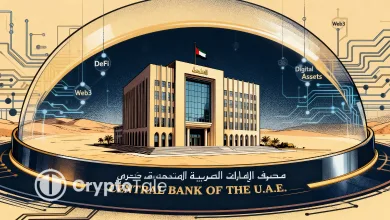South Africa Warns Stablecoins Threaten Key FX Controls

- Stablecoin trading rises fast in South Africa as users shift away from older crypto pairs.
- Regulators plan rules to control cross-border digital flows and limit silent FX risks.
- Global watchdogs warn that stablecoins can reshape monetary tools for emerging markets.
South Africa issued a new warning about stablecoins after regulators observed a rapid shift from volatile cryptocurrencies to dollar-linked digital tokens that cross borders without friction. The South African Reserve Bank (SARB) stated in its latest Financial Stability Review that this trend now poses a direct risk to the country’s exchange-control system because traders can route capital offshore using stablecoins rather than the formal banking network.
Regulators Confront Surge in Dollar-Linked Tokens
SARB noted that the absence of a complete regulatory framework for crypto assets has become a material concern because stablecoins now dominate local markets. The report explained that traders previously relied on Bitcoin pairs, yet the preference has moved sharply toward dollar-pegged assets since 2022. SARB data shows this shift clearly as stablecoin volumes climbed from under 4 billion rand in 2022 to almost 80 billion rand by October 2024.
Herco Steyn, SARB’s lead macroprudential specialist, said the challenge is straightforward: crypto flows operate globally, while South Africa’s exchange rules were built for older financial models. He said, “Without a complementary and full regulatory framework, we do not have sufficient oversight.” He added that progress is expected in 2025, yet the current system cannot handle the speed of digital capital movement.
Furthermore, regulators said that exchanges such as Luno, VALR, and Ovex now serve 7.8 million registered users across the country. Their combined holdings surpassed 25.3 billion rand in 2024, showing that stablecoins have become deeply integrated into South Africa’s retail and institutional trading activity.
SARB warned that this trend allows users to “manufacture” foreign-currency exposure outside official channels. It also said this behavior weakens traditional tools that manage capital flows because digital assets can shift offshore rapidly without detection.
Global Watchdogs Raise Similar Concerns
South Africa’s alert aligns with warnings from global financial bodies. A recent study by an international regulatory group found that stablecoins pose unique risks for emerging markets because many countries cannot monitor cross-border flows or redemption practices in sufficient detail. The report noted that most stablecoins track the U.S. dollar, which adds pressure on nations already struggling with currency shortages.
Additionally, African central banks have started evaluating cross-border USDT activity as stablecoin usage rises in countries facing tight foreign-exchange liquidity. This movement reflects wider concerns shared in regions where capital flight already affects monetary policy operations.
At the same time, the surge in global stablecoin adoption continues. The total stablecoin market reached roughly $314 billion, with Tether’s USDT holding $184.4 billion and Circle’s USDC reaching nearly $75 billion. This growth continued even as the broader crypto market experienced a drawdown.
Countries Push Regulatory Overhauls as Stablecoins Expand
Several countries have enacted new regulations to govern the structural transformations stablecoins have brought about. In mid-2025, the Hong Kong Monetary Authority sanctioned a far-reaching stablecoin statute that mandates total reserve backing, very tight consumer-protection licensing, segregation of client funds, redemption at par value, and AML measures.
Related: Ripple Expands RLUSD in Africa with Chipper Cash and VALR
By promoting the GENIUS Act, the United States enshrined in law control over the status of stablecoins, and the European Union proceeded with MiCA; thus, both regions had their course of regulating stablecoins formally determined.
As stablecoins gain roles in trading, payments, and cross-border transfers, they increasingly operate like digital versions of foreign currency. This development raises the question: How will emerging economies maintain monetary sovereignty when stablecoins move value across borders without relying on traditional financial systems?
Central banks may respond by building new frameworks that include issuer licensing, verified reserve audits, mandatory reporting, and strict redemption standards. These measures could subject stablecoins to the same oversight as other financial institutions.
South Africa’s warning signals the beginning of a broader regulatory wave as countries prepare for a financial environment in which stablecoins become a permanent, influential part of global capital flows.





